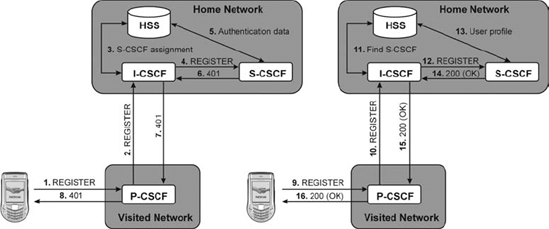3.2. Registration
Prior to IMS registration, which allows the UE to use IMS services, the UE must obtain an IP connectivity bearer and discover an IMS entry point (i.e., the P-CSCF): for example, in the case of General Packet Radio Service (GPRS) access the UE performs the GPRS attach procedure and activates a Packet Data Protocol (PDP) context for SIP signalling. Chapter 17 gives a short overview of the PDP context, and P-CSCF discovery is explained in Section 3.8. This book does not describe the GPRS attach procedure (for further information see [3GPP TS 23.060]).
Figure 3.1. High-level IMS registration.

IMS registration contains two phases: the leftmost part of Figure 3.1 shows the first phase – how the network challenges the UE. The rightmost part of Figure 3.1 shows the second phase – how the UE responds to the challenge and completes the registration.
First, the UE sends a SIP REGISTER request to the discovered P-CSCF. This request would contain, say, an identity to be registered and a home domain name (address of the Interrogating-CSCF, or I-CSCF). The P-CSCF processes the REGISTER request and uses the provided home domain name to resolve the IP address of the I-CSCF. The I-CSCF, in turn, will contact the Home Subscriber Server (HSS) to fetch the required capabilities for S-CSCF selection. After S-CSCF selection the I-CSCF forwards the REGISTER request to the S-CSCF. The ...
Get The IMS: IP Multimedia Concepts And Services, Second Edition now with the O’Reilly learning platform.
O’Reilly members experience books, live events, courses curated by job role, and more from O’Reilly and nearly 200 top publishers.

